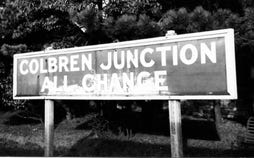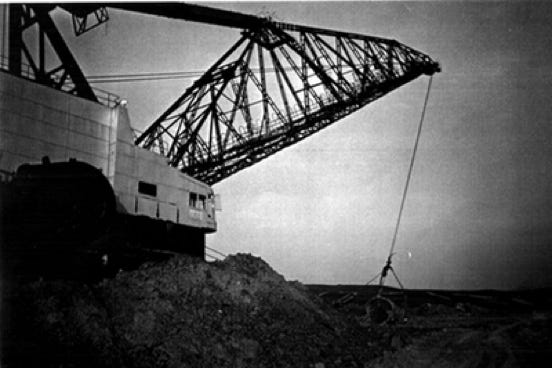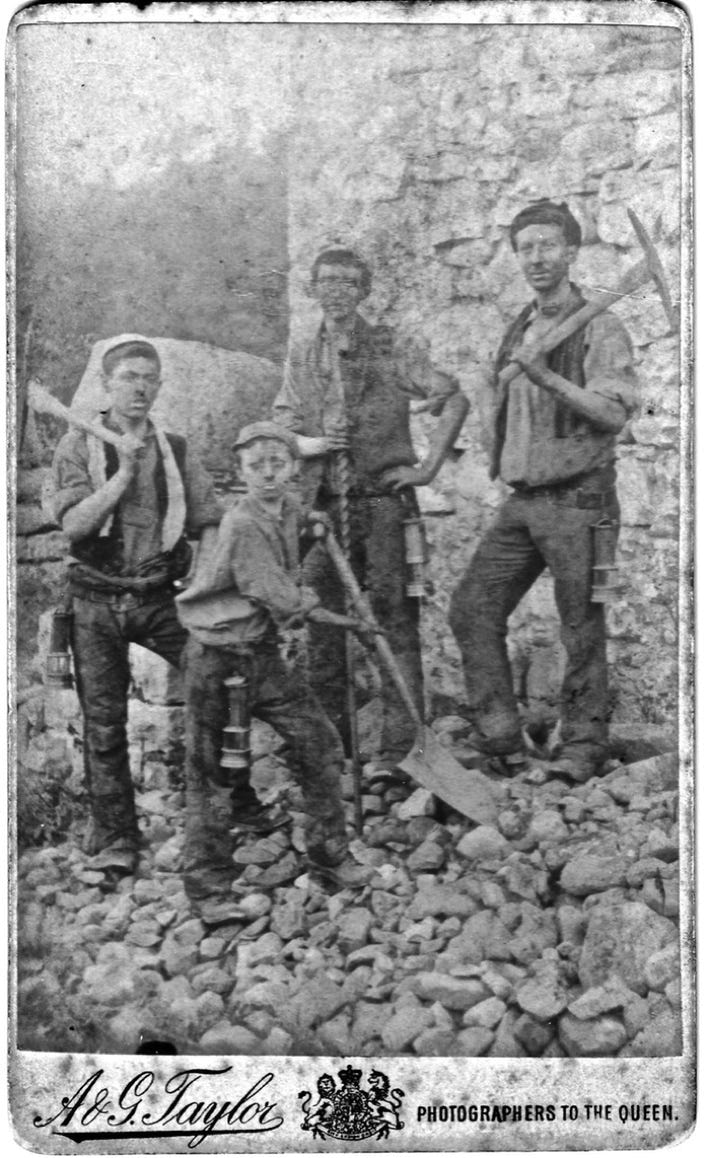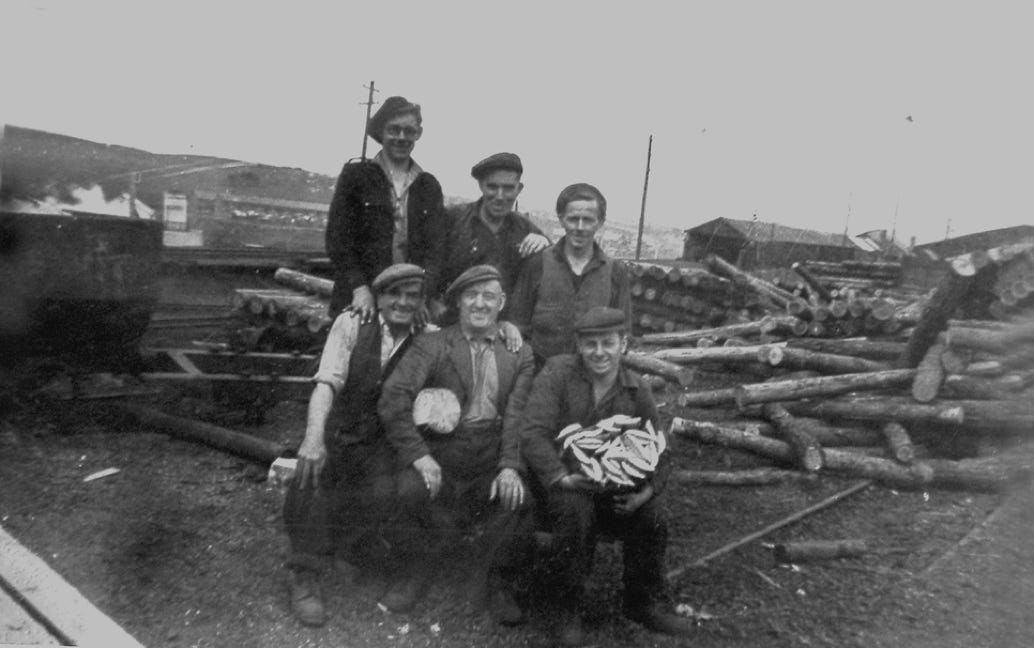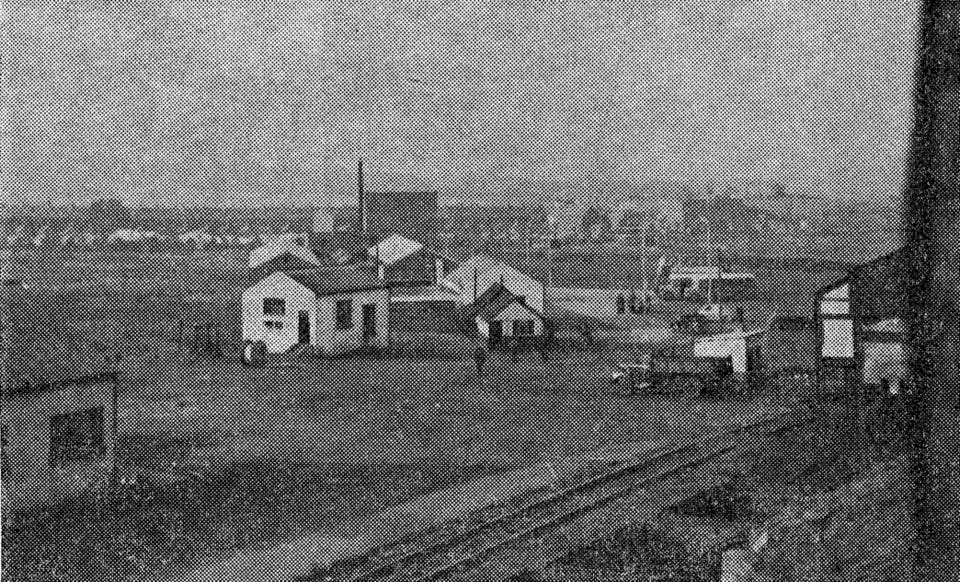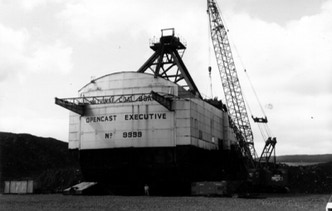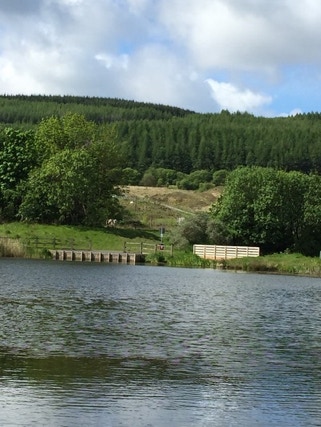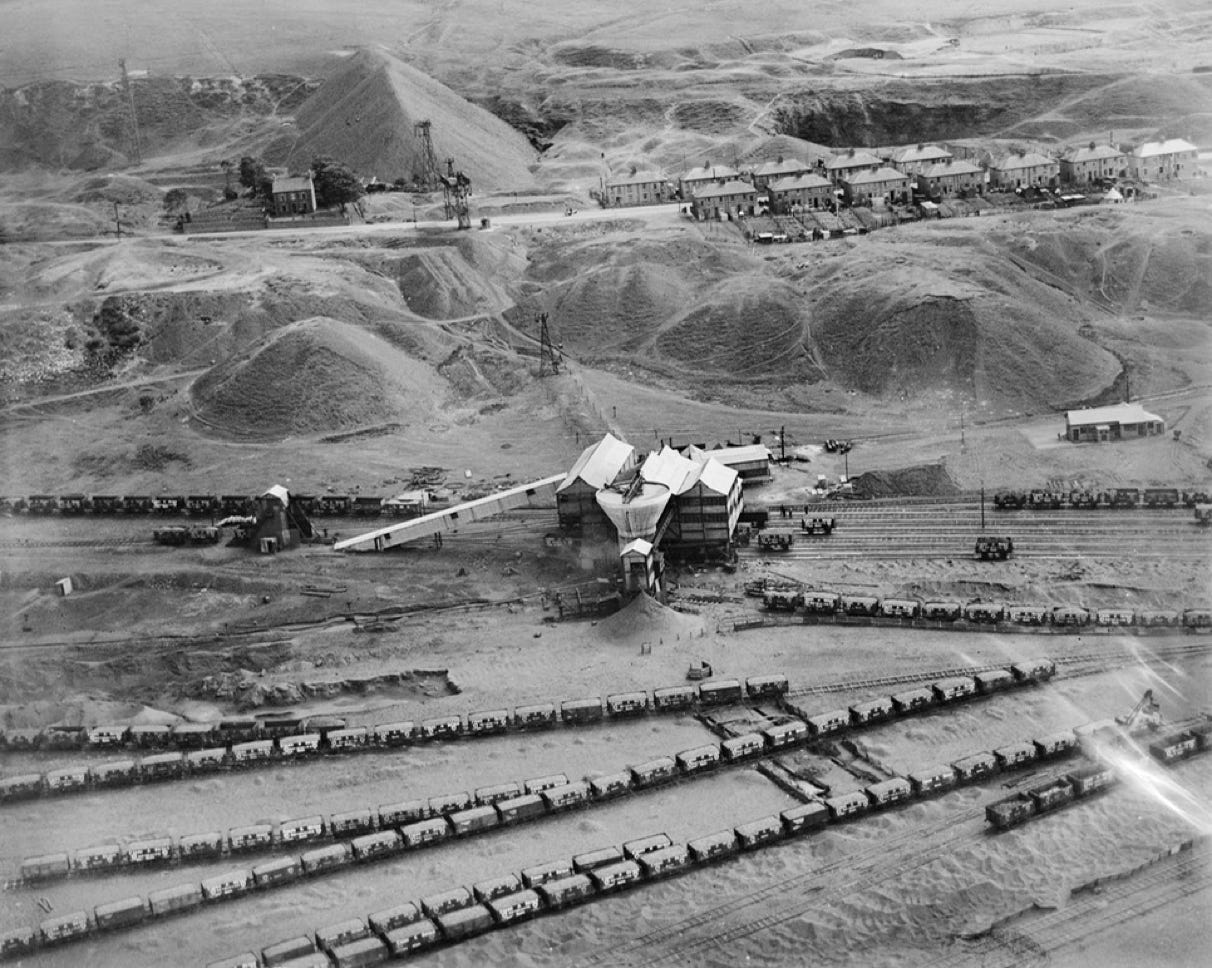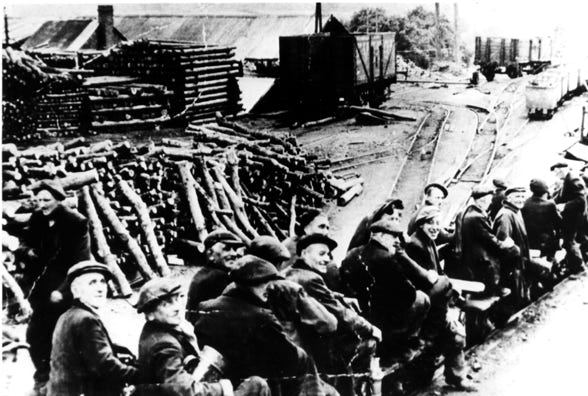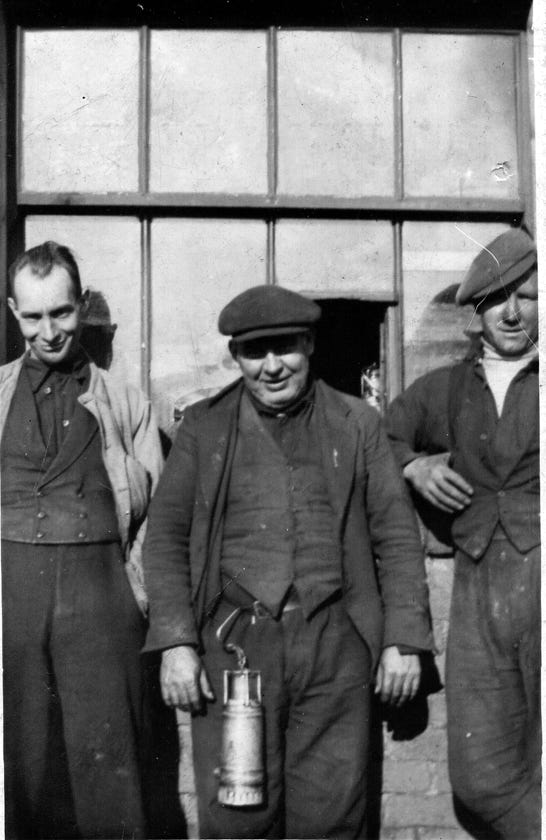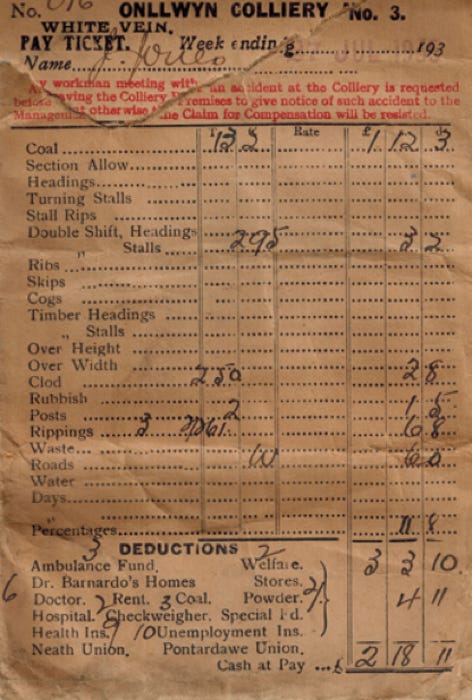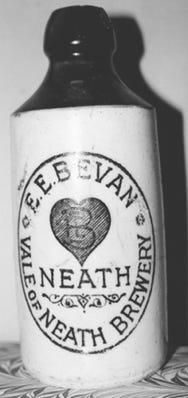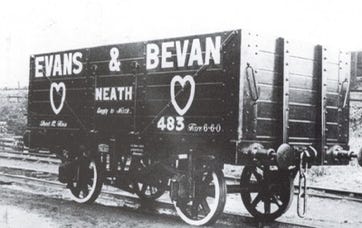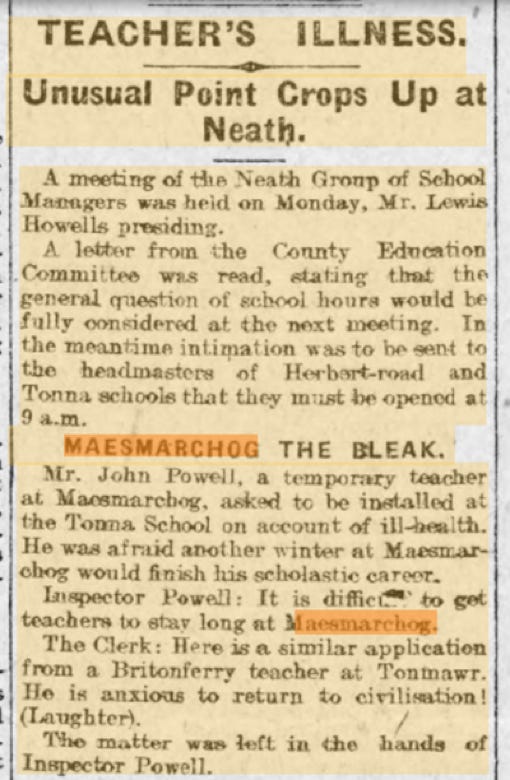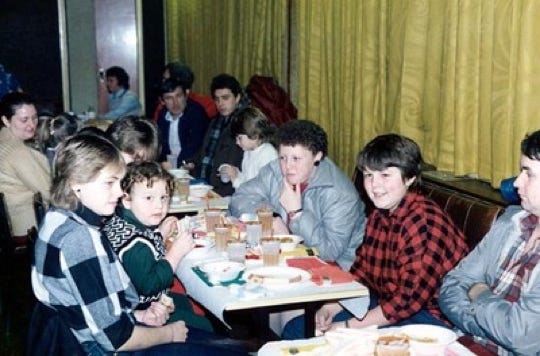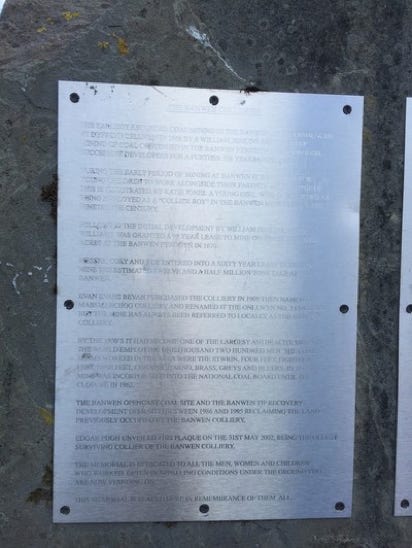Above: these young miners are likely to have been photographed somewhere around the Onllwyn/Banwen collieries, perhaps in the 1870s-1880s. Unfortunately they cannot be identified but are thought to have been either from the Jeffreys or Alexander families. Each has one of the essential tools of the trade: pick, shovel or long boring drill bit. All of course have a lamp. Photo kindly provided by J. Alexander, Sept. 2019.
There is no set date for the establishment of a colliery at Banwen: because the coal was outcropping close to the surface, here at the rim of the coalfield basin, much of it had always been easily accessible and did not require the large amounts of capital involved in the more binary establishments of the eastern valleys which needed elaborate pit-sinking operations to get going. Coal had been taken here in greater or lesser form for centuries, sometimes purely for domestic purposes.
Nonetheless, at the beginning of the nineteenth century, activity began to be consolidated in a more organised way around the Maesmarchog drifts as there was clearly potential for sustained extraction. Outside capital began to be interested and a succession of owners developed the drifts into the usual industrial organisation. An official Maesmarchog colliery railway was started as an extension to the Neath and Brecon line from 1864 (28 /111863 - Brecon Reporter and South Wales General
Advertiser)
The colliery went under a number of names - Maesmarchog, Banwen - and was last officially known as “Onllwyn No. 3”. It was part of the “anthracite belt” and this was in general slightly distinguished from other south Walian coal communities: it was found, firstly, towards the north western edge of the overall coal basin; then there was a difference in extraction methods, here, due to the geography, usually accessed via drifts rather than shafts, and finally perhaps even a difference in people and community. One important difference was that the anthracite area tended to be more generally prosperous than other areas.
To begin with though, these were very early collieries, hidden away and supporting small community outposts up on the moor and bog for quite some time before organised capital found them. Even then, access was difficult, if only in perception, and the indigenous population tended to stay put. While there was substantial in-migration in the boom years of the mid nineteenth century, these newcomers worked alongside people who were already there and the tops of these high valleys remained relatively sealed until well into the twentieth century. Their Welsh speaking heritage was thus transmitted in relatively undiluted form down the generations and thus there was less apparent discordance later, possibly, in an Onllwyn-born, Welsh speaking Communist general secretary of the south Wales NUM (Dai Francis, 1911-81) being a bard of the National Eisteddfod, and establishing a bilingual Miners’ Eisteddfod.
In the more heterogenous and amorphously-populous eastern valleys, such a position would have been difficult on different cultural and political levels. The “apartness” (Francis & Smith, 1998) of the anthracite area, which is a recurring leitmotif among many commentators and observers, seems to have conveyed some special status on its representatives. Nonetheless, some dilution of the population took place daily as the labour needs of the local collieries could not be met by local men alone. Thus,
“Men came from all parts of the country to share in this new prosperity - many to remain and settle in the village” (Evans, 1964)
Otherwise, men came daily, either part way by train or by walking on the railway line. There were no roads yet, just cart tracks, liable to mud and flooding.
“They came from the Swansea Valley, crossing Mynydd-y-Drum. They crossed the mountain by day and night - in the darkness of the early morning and the late evening, lighting their way with small hand lamps. At times the mountain looked like a moving fairyland, studded with brightly-coloured lights.” (Evans 1964)
At the surface of Banwen mine. The timber is destined to be cut and shaped before being taken into the mine. In the basket I believe are wooden notches used to tightly wedge in the horizontal timber supports to the uprights. Part of the collier’s job was to maintain the roofs and they were paid for this on a piece basis, as for anything else.
The ownership of these anthracite mines at the valley heads also differed slightly from the rest of the coalfield. There was a procession of more and less successful individual coal owners throughout the nineteenth century, but by 1909, the Evans Bevan company controlled all the Dulais Valley mines. Much of the land and farms were bought by David Bevan in 1885, at the dispersal of the Miers estate. However, the resultant Evans-Bevan company appears to have been less of a “combine” than other much larger concerns such as the Powell-Duffryn Company or the Ocean Collieries Company, and was at least managed quite locally, from Neath. While there was undoubted ongoing general antipathy between owner and workers, sometimes expressed as hatred of particular colliery managers, there was possibly less outright alienation between the two than in other areas and some commentaries describe the company in reasonably complimentary terms. This may, of course, have simply reflected the fact that this was a prosperous coal area, with the valuable anthracite - and the men’s labour - in great demand.
“At the YMCA end of Dyfryn Cellwen were a half dozen or so bungalows, built in the last five six or years (i.e. about 1939). Some were built of brick, others of asbestos and timber - these would have been bought from a catalogue and delivered in sections ready for erection. There was a dozen of that type of bungalow on the Glyn Neath/Banwen road. It was one of the very visible signs of the benefits of the prosperity, the mining of anthracite coal had brought to the valley in the late thirties, with the design of household stoves and industrial generators to burn the hard smokeless coal. Colliers were able to buy land and build their own houses.” (Evans, 2006).
The market for anthracite was also essentially export and paradoxically it suffered a crisis in the second world war with the loss its principal French market. After nationalisation in 1947, there was a great deal of trouble for the NCB and NUM jointly, in unpicking some of the very complicated wage arrangements (involving creative applications of the price-list) previously made entirely unilaterally, without reference to the Fed at Cardiff, generally in the miners’ favour, evidence some suggest (Francis & Smith, 1998; Evans, 1976) of a more considered and enlightened form of industrial relations here, but again different to the rest of the coalfield. Later, when amalgamation and closures began to bite in this area as well as others, orchestrated by the oft derided “N C bloody B” (National Coal Board) now held by some as simply a highly bureaucratised organ of now state rather than private capitalism, complete with its own monied elite, there appears to have been some nostalgia for the company way of doing things. “The Evans Bevan family were never known to evict.” (GB Evans, 2006, p17). At least, it seems to be suggested sometimes, the men knew who they were dealing with under Evans-Bevan.
Until the mid 1980s, coal mining was a given, seemingly immutable part of British industry. Miners could and regularly did bring the country to near standstill through strike action and their leaders were among the most powerful and regularly villified union “barons”, always at the top table in government negotiations before Margaret Thatcher decided to finish them. As the twentieth century wore on, coal’s power became somewhat mythologised although the truth of the economics increasingly denied that prominence real credibility. The myth of the miner was enough to keep his image held high. Some suggest coal’s real importance in the national economy was finished sometime after the first world war and this was particularly true in these first boom areas in south Wales. The reality here at least was that narrow, old mines like Banwen were almost worn out by the end of the second world war and would never be able to operate properly in the machine-cutting age. Banwen limped on through the 1950s, shedding jobs, tinkering half-heartedly with modernisation but reducing tonnage and manpower gradually until final closure in 1962. Even then, close to 500 men lost their jobs.Above: Ransome Drag Line machines used in open cast mining around Banwen and Onllwyn from the 1960s. Source WT Davies, Now and Then series
After the colliery closed in February 1962, the opencast operations continued. Huge machines churned up the surface of the colliery. Heavy blasting shook the houses. The opencast worked to within thirty yards of the houses. Apart from the pithead baths and the colliery canteen, the colliery has now disappeared and with it a life-time of struggle by miners. The old rubbish tips have been smoothed over ready for the forestry to plant trees.
Evans (1977)
Above: looking up to Hirfynnydd mountain and the site of Banwen Colliery today: very little of this landscape is natural or indigenous.
Photo by G. Jones, 2015
The local historian Chris Evans (1911-1993) saw this happening in the 1960s, when he finished his account of the village of Seven Sisters.
"Hirfynydd bears the scars of forestry, the young saplings have taken root, in a few years' time the surrounding mountains will once more be covered with that dark green look. Will the village then be forgotten? Will it return to the days of long ago with nothing to disturb its peaceful surroundings but the murmurings of the streams, the braying of the beast and the sweet twittering of birds and the memories of old men?"
Evans (1977)
Needless to say, he correctly foresaw a now well-advanced process. The only reason for the existence of the villages here was the iron foundries and the mines; their presence now seems superfluous and it seems the mountain wants the moor back, having suffered so much rude and unnatural ingress. There are strange, illogical and sinking road systems left, laid originally for the collieries, a lot now unnecessary, clearly under used and most badly maintained. Now purposeless railway bridges float meaninglessly above grassy voids. There hasn’t been an obvious rush to prettify the place as there apparently seems no need. The pubs, but for hundreds of men with money to spend daily, ground to a halt decades ago, practically all now demolished, and nothing replacing them. Why does this feel so different to so many other de-industrialised parts of the UK, indeed even to other old mining areas? It is because we are still right on the margin and never were anywhere else, nothing abides on the high moor under the big skies miles from anywhere and many good reasons to be somewhere else; there was no other original reason to be here than coal and the fundamental plausibility of sustained life now seems resoundingly weak.
Altogether, this looks like a photograph taken on another planet or a “Mad Max” film-set: a pre-1947 north-south view of of the next-door Onllwyn washery, which would have processed Banwen coal, with the spoil tips clearly visible around the Wembley Avenue Onllwyn housing. The distinctive heart-shaped logo of the Evans-Bevans company is just about discernable on the coal wagons (example of which shown below, and on the Evan Bevans original brewing concern: source WT Davies, Now and Then series).
© Crown copyright: Royal Commission on the Ancient and Historical Monuments of Wales: Aerofilms Collection. Reproduced here under Licence no: RCPL2/3/62/022
More photographs in this series are freely accessible at:
https://www.britainfromabove.org.uk/en/search
